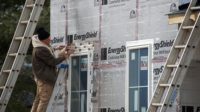The use of continuous insulation has long been adopted throughout Eastern Europe as a way to improve energy efficiency. For countries like Germany, where their energy sources are at risk, conserving what they can becomes a paramount endeavor. As a result, standards have become more rigid over the past decades. However, what is common in Europe has been slow to take hold in North America, until now.
What’s driving the growth of continuous insulation throughout North America? Environmental, comfort, health and safety impacts are all at the top of the list. While we have the overall luxury of less expensive energy, environmental issues are becoming increasingly more important. The combination of these challenges and necessary energy code changes is positioning continuous insulation as the solution to many of the energy-loss problems on the market today. Still rather new in some areas of the country, we’re seeing a solid pattern of growth for continuous insulation on the horizon.
CI Energy Codes
Following the traditional method of stick-built construction, a structure can lose upwards of 25 percent of its energy1 due to thermal bridging, which occurs when a building component, like a wall stud, conducts heat faster than the building materials around it, creating an easy path for heat transfer. Because of this very real threat, we’re seeing codes changing across the country, the required R-value increasing and the use of continuous insulation as the preferred method approaching the norm. Energy codes are beginning to require more insulation to address energy loss and gain in commercial and residential projects.
In addition, these changing codes are right on target. Continuous insulation provides an uninterrupted thermal barrier, helping to reduce or eliminate thermal bridging, making it the most effective way for a structure to achieve the necessary R-value to meet code.
Looking across the industry as a whole, there are multiple continuous insulation solutions on the market, some of which have been around for a long time. Adoption of code changes can be slow. Nevertheless, as the industry pivots to expect higher levels of provable energy efficiency in construction, updated codes will frame the path for the development of innovative products designed to meet new environmental demands.
Traditionally thought of as only needed in commercial buildings or cold climates, continuous insulation is being used more in residential construction, as well as in warmer climates, to retain conditioned air.

Finding the Right CI
With many different continuous insulations on the market today, how do you select the right one? Polyisocyanurate or polyiso, has been on the market for more than 40 years as a leader with its environmentally friendly, closed-cell foam structure and high thermal resistance. The product has one of the highest R-values in a thin profile, offering the best value-to-price ratio.
Polyiso is made with high-performance facers and, when properly treated, can work as an integrated air and moisture barrier. It also works with more cladding options than any other foam plastic, providing flexibility for designers (not to mention decades of proven performance in roof assemblies).
Did you know that polyiso continuous insulation could reduce project costs and time because it can serve as a multipurpose product? As mentioned, when installed properly, polyiso is a code-compliant air- and water-resistive barrier, which can eliminate the need for a separate membrane, effectively reducing complexity in the wall assembly. Selecting polyiso continuous insulation means your building is more comfortable with reduced energy demand and inherent moisture control. Polyiso also helps contribute to better indoor air quality and is validated through third-party programs, like UL GreenGuard Gold, leading to safer and healthier interior spaces. This proper use of control layers (air, vapor, moisture and thermal) helps to avoid problems with unwanted vapor transmission, moisture and air movement.
Considering the environmental impact of polyiso products, the goal is to have as many of the control layers managed with as few layers as possible, meaning fewer mistakes and fewer materials. In the case of polyiso, the energy used to manufacture the product is less than the alternatives. Additionally, with a large manufacturing footprint across North America, the carbon footprint incurred with trucking the product to its destination is significantly lessened. Additionally, polyiso offers zero ozone-depletion potential and low global-warming potential.
What the Future Holds
What’s next for continuous insulation? There are new polyiso solutions. Some polyiso continuous insulation systems on the market can be used above and below grade, featuring additional benefits to help simplify project complexity. Besides multi-functionality as an air- and water-resistive barrier, there is a greater R-value per inch in a thinner profile, better thermal stability for less distortion under heat, maximum compatibility with adjacent materials, including solvents, a greater level of fire and moisture resistance, and is easy to handle and install at the job site. The thinner the profile, the more sheets per truckload and the greater the overall footprint, in both storage and your wall profile.
Are you considering continuous insulation for your next project? Do your research and compare the options. Consider consulting an unbiased resource, such as continuousinsulation.com, for basic research and in-depth technical guides addressing all foam plastic continuous insulation options, including polyiso. Find the product that offers the most flexibility and delivers the most return on investment, all while being code-compliant and attractively priced. We think you’ll enjoy working with polyiso.
References
- Calculations are based on ASHRAE 90.1 and Appendix A and only include studs, insulation and sheathing values.







